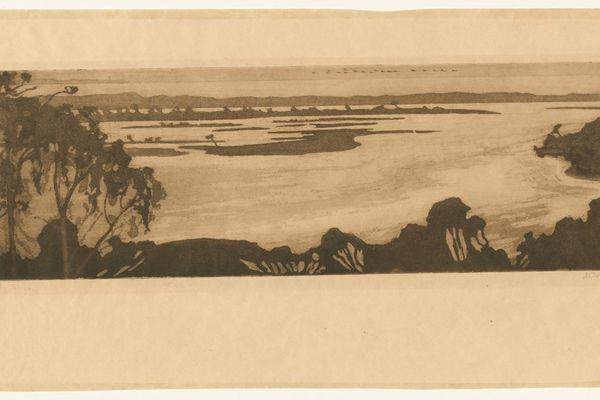Home at last
13 Sep 2008 – 8 Mar 2009

Grace Cossington Smith, Interior with verandah doors, 1954, Canberra Bequest of Lucy Swanton 1982
About
Designed especially for children, Home at last encourages children to think about ideas of the home through artworks about home life and house objects from different times, places and cultures.
For many it is the relationships within the household that make a house a home. The prints, paintings and photographs in this exhibition explore everyday ideas of home and family life, including extended family, friends and much–loved pets.
Some artists comment on the place of the home in Australian popular culture. One colourful example is Howard Arkley’s painting Floral exterior which explores the Australian dream of the suburban home. Inspired by advertising and magazines, Arkley imposes interior decoration on the exterior of the house.
Indigenous Australian works in the exhibition show how the artists’ close connections to home can be expressed through their choice of materials, techniques and function. Golbordok (a traditional bush honey collecting bag) is closely woven from pandanus fibre and embedded with wax to ingeniously prevent leakage.
Inside the homelike exhibition space of Home at last, preschool and primary school children are encouraged to take a fresh look at the familiar and to imagine the experience of others.
Exhibition Themes
Children and the home
For young children, the home is the centre of their world and the focus of family life and, as they grow, they branch out into the wider world from this home base.
The children's exhibition Home at last provides a child’s eye–view of the Australian home across time, place and culture. It features a range of new and familiar media, techniques and objects by Australian artists in the National Gallery of Australia’s collection.
Ideas of home
The home is a popular subject for artists, particularly their own home, which is easily accessible, relevant, known and loved. Grace Cossington Smith’s Interior with veranda doors 1954 captures the intimate, memory-filled spaces of her family home. One of the artist’s sketchbooks (an intimate, portable and affordable format for drawing in and around the home) is included in the exhibition.
For many it is the relationships within the household that make a house a home. The prints, paintings and photographs in the exhibition explore every day moments and ideas of home and family life, including extended family, friends and much–loved pets. Through the familiar process of photography, Robert McFarlane portrays a warm family gathering in Grandmother Lily McFarlane (nee Gelsthorpe Brimage) at a dinner for her 77th birthday at our family home at Downing Street, Brighton, Adelaide 1964. Atmospheric light captures the faces of family watching and waiting in anticipation as the candles are lit.
The home in society
Some artists comment on the place of the home in Australian society. Howard Arkley’s painting Floral exterior 1996 explores the Australian dream of the suburban home. Inspired by advertising and magazines, Arkley imposes interior decoration on the exterior of the house. The stencil process is also used by Adrian Doyle, who presents a nostalgic Australian childhood memory in Boy on a clothes line 2003. Another Australian icon is introduced to the children in Margaret Dodd’s Holden with lipstick surfboards 1977 — a famous Australian family car with a twist.
The Indigenous Australian works of art in the exhibition show the artists’ close connections to home through their choice of materials and techniques and the function of their work. Golbordok (a traditional bush honey collecting bag) 1989 is closely woven from pandanus fibre and embedded with wax to ingeniously prevent leakage. The bag was woven by Margaret Rinybuma and decorated with ochres by her husband Michael Gadjawala from Maningrida in Central Arnhem Land.
Elaine Russell’s painting Little orphans 2004 illustrates an episode from her childhood at Murrin Bridge Mission on the Lachlan River in central New South Wales in the 1940s and 1950s. In this scene she depicts herself being followed home from a swim in the pond by a family of ducklings. The image alludes to a childhood spent growing up in a loving family, living in difficult circumstances. The painting is displayed alongside a work from the Frances Derham collection of child art, Mt Margaret Mission, Western Australia 1939 by thirteen-year-old Boongie Nindarngar. The annotated drawing includes a photograph of the artist and is a map of his mission home, defining his world. (read more about the Frances Derham collection)
Leaving home and starting again in an unfamiliar place is an experience common to many Australians throughout history. Abraham Solomon’s painting Second class – the parting: Thus part we rich in sorrow parting poor 1854 and David Moore’s photograph Migrants arriving in Sydney 1966 introduce children to the migration experience. They reveal the mixed feelings associated with leaving the familiar and encountering the new.
Engage with the works
Inside the homelike exhibition space, preschool and primary children are encouraged to take a fresh look at the familiar and imagine the experience of others by engaging with art.
Children have the opportunity to make a creative response to the exhibition by drawing and building small homes. Visitors can attempt to identify secret sounds and the works of art that match them, and can try to guess the functions of mystery objects. Many of the works evoke sensory associations and memories of the sights, sounds, smells, tastes and feel of the home environment.
Take a journey through the exhibition with someone of a different age to yourself and talk about your diverse and shared experiences.
Joanna Krabman
Educator, Family and School Programs










